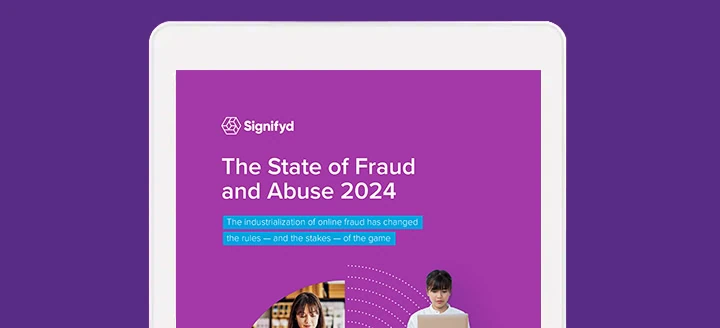It’s said that you need the right tools to do the job right. True enough. But in the world of ecommerce — specifically when it comes to customer experience — the advice is evolving beyond tools.
Today, you need the right data for the job.
Data and customer experience were top of mind for many attendees at Signifyd’s FLOW Summit 2022.
Personalization topped the customer experience list for Forrester Vice President and Principal Analyst Brendan Witcher. But personalization, which is one slippery fish to catch, was also near the top when it comes to degree of difficulty. As Witcher explained, the idea of a personalized experience is subjective and entirely up to the customer to define.

Forrester’s Brendan Witcher
The best way to achieve something so essential, but so very abstract? Individualization, the shiny, more advanced version of segmentation. For merchants to unlock this new level, they must engage with segments one at a time in real time by listening, capturing, measuring, assessing and addressing intent across all touchpoints.
Now this may sound tedious, and it is. But it’s not impossible.
An explosion of data
Enter Lockie Andrews, founder of Catalyst Consulting, chief growth officer at Pura Vida, board member of Crypto Chicks and most recently, session speaker at FLOW Summit.
During her presentation, Building Brands for Scale: Customer 360 Andrews laid out how merchants can build a better brand and brand experience with analytics. Citing a recent IBM study, Andrews’ noted that at present there is an explosion of data due to the upsurge of cloud, mobility, IoT and social to name a few areas; and with the advancement of these data sources, there has been a concurrent explosion of digital touchpoints.
Andrews’ shared that the previous customer lifecycle had four touchpoints. Today, the number of touchpoints in the digital customer lifecycle has well surpassed 16 — and that number continues to climb.
So merchants are faced with another mountain to ascend. Witcher explained that to achieve individualization each of the touchpoints needs to be fully digested by the merchant: Is this new behavior? What does this interaction mean? Is this a good experience for the customer?
Watch Lockie Andrews’ and Brendan Witcher’s full FLOW presentations
The right tools can help online retailers succeed, but today the real need is for the right data — used the right way. At FLOW Summit 2022 in New York City, Forrester Vice President and Principal Analyst Brendan Witcher and Catalyst Consulting Founder Lockie Andrews made the point in different ways in separate presentations.
Watch Lockie Andrews’ presentation where she explains the importance of a 360-degree view of the customer. Check out Brendan Witcher’s talk explaining the importance of personalization and how to think about it.
But if this practice needs to be conducted at each of these seemingly ever-growing number of touchpoints, how can a merchant stomach it all?
Say hello to Customer 360
Fortunately, Andrews delivers some good news: Merchants today already have the right infrastructure to capitalize and collect all the data available across these modern-day digital touchpoints.
She set up her advice with a quote from BBC News Manager John Naisbitt, “We are drowing in information but starved for knowledge.” Andrews explains that it is up to the merchant to derive meaning and insights from the surplus of data that they already have.
This is where Customer 360 comes into play. As Andrews outlines it, Customer 360 is the creation of a master customer record that combines all the demographic, psychographic, purchase history and interactions related to a merchant’s brand.

Lockie Andrews
Now Customer 360 goes by many names depending on the organization. There’s customer profile or the “golden ticket” for those more whimsical in nature. Regardless of what it is called, Andrews says, “What (Customer 360) reflects is a singular place that combines all the information about your customer so you understand who that customer actually is, the products that they love and how they are engaging with your inventory in your channels.”
The backbone of omnichannel strategy
For digitally native brands, Customer 360 equips them to understand their customer, what they want, how they want to shop and it enables them to meet all their needs in a seamless nature.
Customer 360 is truly the backbone of omnichannel strategy, Andrews says. It creates a unified product catalog; from in-store employees having insight into online exclusives to knowing what the inventory is to understanding what the customer’s needs are. Merchants who properly equip a Customer 360 strategy are able to provide frictionless, personalized customer experiences.
Not only does Customer 360 enable merchants to provide unrivaled service to their customers, but it has been shown that good customer experience carries major payoff. When it comes to a good customer experience, 86% of buyers were willing to pay more to get it and many companies listed customer experience as one of their top strategic revenue drivers.
Launching Customer 360 in 3, 2, 1
Coming full circle, the effort required for merchants to get started with their own Customer 360 strategy is relatively low.
“First, start with your data and determine what matters most to your customers,” Andrews instructs. “You don’t have to do everything, that’s the beauty of it. It doesn’t mean that you need to cover every need. Instead, it means you need to arrange the pieces to start where you are so you can satisfy your customers and their most frequent friction points that exist today.”
To achieve that singular data entity that Customer 360 is known for, Andrews notes that merchants should begin consolidating their data. “With a centralized hub, merchants can start to structure that unstructured data,” Andrews says. “That will get a merchant started on that Customer 360 journey and understanding what insights really mean for their customer base.”
Second, Andrews advises that merchants break their Customer 360 strategy into “meaty but meaningful” phases.
By identifying and breaking down what matters to a merchant’s customer base they can achieve demonstrable improvements in sales to further bring internal stakeholders on board. This part is key, Andrews says, as “you can start to prove — just with your transaction reporting — that you can start to see behaviors and then segment the customer to show you’re getting the behaviors you want that ultimately equate to higher sales.”
“From there, you can then move into the 360-degree view of the customer once you have all of that data in one place,” Andrews says. The immediate impact here is that now merchants can strategically determine where to spend their marketing dollars and increase ROI; so if a customer is shown through Customer 360 to strictly prefer shopping online, a merchant knows to not target them with ads, sales or prompts with the intention of driving them in-store — instead they know to engage with them through other digital channels that drive them to the website for instance to achieve a higher chance at conversion.
Finally, Andrews advises that merchants understand and set up self-service analytics for all of their customers. She notes that if customers want to understand their behaviors then it provides a greater opportunity and level of insight for merchants to understand those behaviors as well. “If we observe customers and their behaviors,” Andrews says, “then merchants can emulate what matters most to those customers.”
When all paired together, a frictionless Customer 360 strategy is born. The ultimate culmination of cross channel data and center source of truth that merchants can turn to for exact types of insights they need to truly understand their customers and deliver that truly seamless and personalized experience they crave.
All it takes is a little data.
Photos by Amy Lane Albro for Signifyd
Let’s talk about succeeding with data












